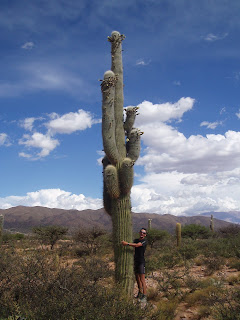



Another six-day week at the (handle) bar and another 550km, so we're a bit puffed out today and have been flopping about in the small Argentine town of Belen. It's long odds for a white Xmas here as it is a sunny 25°C and excellent beer-drinking weather (although it's over 40°C down on the plains, so we won't be going there). The route along Route 40 from Salta took in fine sandstone canyons and the scenic wine-growing Cafayate region (nice chilled Turrontes whites). Our addiction to steak continues in an effort to put back on some of the 5kg we have collectively lost - no need for a post-Xmas slimming regime here. We also experienced the strong local Zonda desert wind, both for and against us, which was good practice for windy Patagonia. Local Xmas preparations are muted (apart from lots of firework buying - could be noisy tonight) and a huge contrast to 'Shop until you drop' UK. From here we continue south to Mendoza (another wine-growing area...) after New Year. Best seasonal greetings, Clive & Liz.















































